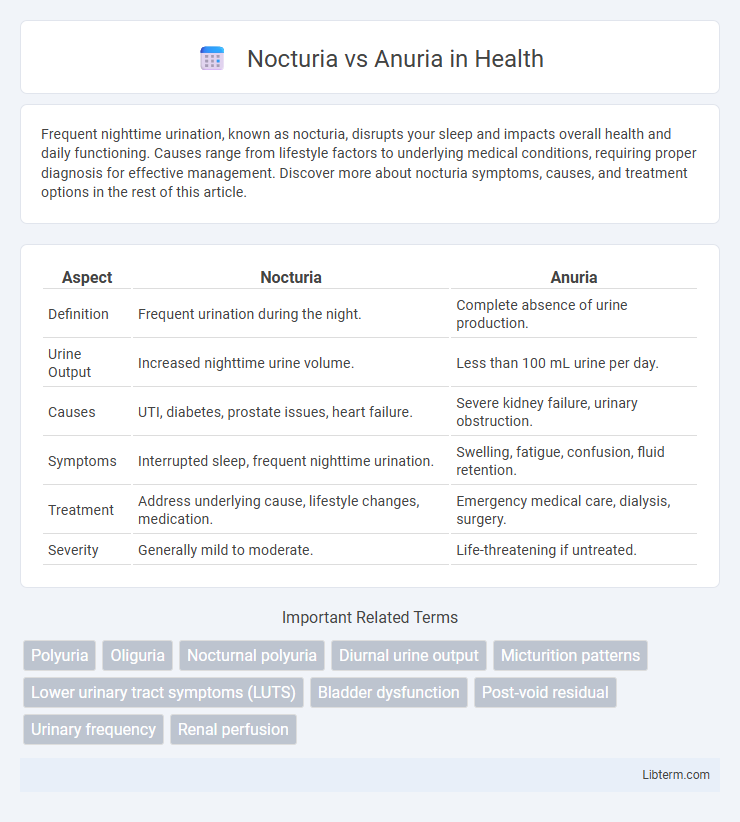Frequent nighttime urination, known as nocturia, disrupts your sleep and impacts overall health and daily functioning. Causes range from lifestyle factors to underlying medical conditions, requiring proper diagnosis for effective management. Discover more about nocturia symptoms, causes, and treatment options in the rest of this article.
Table of Comparison
| Aspect | Nocturia | Anuria |
|---|---|---|
| Definition | Frequent urination during the night. | Complete absence of urine production. |
| Urine Output | Increased nighttime urine volume. | Less than 100 mL urine per day. |
| Causes | UTI, diabetes, prostate issues, heart failure. | Severe kidney failure, urinary obstruction. |
| Symptoms | Interrupted sleep, frequent nighttime urination. | Swelling, fatigue, confusion, fluid retention. |
| Treatment | Address underlying cause, lifestyle changes, medication. | Emergency medical care, dialysis, surgery. |
| Severity | Generally mild to moderate. | Life-threatening if untreated. |
Understanding Nocturia and Anuria
Nocturia is characterized by frequent urination during the night, often disrupting sleep, and is commonly caused by conditions such as diabetes, bladder obstruction, or aging. Anuria refers to the complete absence of urine production, typically signaling severe kidney dysfunction or urinary tract obstruction requiring immediate medical attention. Understanding the distinction between nocturia and anuria is crucial for accurate diagnosis and effective treatment of underlying urinary or renal disorders.
Key Differences Between Nocturia and Anuria
Nocturia is characterized by frequent urination during the night, disrupting sleep patterns, whereas anuria is the complete absence of urine production, indicating severe kidney dysfunction or urinary tract obstruction. Nocturia commonly results from conditions such as diabetes, heart failure, or bladder disorders, while anuria often signals acute kidney failure or bilateral ureteral obstruction. Distinguishing between these conditions is critical for diagnosis and treatment, as nocturia typically requires managing underlying causes, whereas anuria demands urgent medical intervention.
Causes of Nocturia
Nocturia, characterized by frequent urination during the night, is primarily caused by conditions such as diabetes mellitus, congestive heart failure, and sleep apnea, which increase urine production or disrupt bladder function. Other factors contributing to nocturia include aging-related changes in bladder capacity, use of diuretics, and urinary tract infections. Unlike anuria, which involves the complete absence of urine production typically due to severe kidney failure or urinary obstruction, nocturia involves excessive nighttime urination linked to systemic or urological issues.
Causes of Anuria
Anuria, characterized by the absence of urine production, primarily results from severe acute kidney injury, bilateral urinary tract obstruction, or advanced chronic kidney disease. Causes include conditions such as acute tubular necrosis, acute glomerulonephritis, and obstructive uropathy due to kidney stones or tumors. Unlike nocturia, which involves frequent nighttime urination, anuria signifies a critical loss of renal function requiring immediate medical intervention.
Symptoms: Nocturia vs. Anuria
Nocturia is characterized by the frequent need to urinate during the night, disrupting sleep and often linked to underlying conditions such as diabetes or bladder obstruction. Anuria involves the almost complete absence of urine output, signaling severe kidney dysfunction or urinary tract obstruction and requiring urgent medical evaluation. While nocturia indicates excessive nighttime urination, anuria represents a critical reduction in urine production.
Risk Factors and Predisposing Conditions
Nocturia, characterized by frequent nighttime urination, is commonly linked to risk factors such as aging, diabetes mellitus, heart failure, and sleep disorders. Anuria, defined as the absence of urine output, often results from severe acute kidney injury, urinary tract obstruction, or chronic kidney disease. Predisposing conditions for nocturia include benign prostatic hyperplasia and overactive bladder, whereas anuria is typically associated with conditions causing renal hypoperfusion or urinary obstruction.
Diagnostic Approaches for Nocturia and Anuria
Diagnostic approaches for nocturia involve detailed patient history, frequency-volume charts, and urinalysis to identify underlying causes such as bladder dysfunction or sleep disorders. Anuria diagnosis requires urgent assessment through serum creatinine levels, bladder ultrasound, and evaluation of obstructive uropathies or acute kidney injury. Both conditions necessitate targeted diagnostic imaging and laboratory tests to differentiate etiology and guide effective treatment strategies.
Treatment Options for Nocturia
Nocturia treatment options primarily include lifestyle modifications such as fluid restriction before bedtime, managing underlying conditions like diabetes or heart failure, and medication like antidiuretics or bladder relaxants. Behavioral therapies, including bladder training and pelvic floor exercises, can also reduce nighttime urination frequency. Unlike anuria, which necessitates immediate medical intervention due to kidney failure or urinary obstruction, nocturia management focuses on symptom relief and improving quality of life.
Management Strategies for Anuria
Management strategies for anuria primarily involve urgent medical interventions to restore urine output and address underlying causes such as acute kidney injury or urinary obstruction. Treatment may include hemodialysis, fluid management, and correcting electrolyte imbalances to prevent life-threatening complications. Early diagnosis through renal function tests and imaging is critical for optimizing outcomes and guiding appropriate therapeutic approaches.
Preventive Measures and Patient Education
Preventive measures for nocturia include managing fluid intake, especially limiting caffeine and alcohol, and addressing underlying conditions like diabetes or sleep apnea. For anuria, early recognition and treatment of kidney failure or urinary tract obstruction are critical to prevent progression. Educating patients on symptom awareness, adherence to medication, and lifestyle modifications ensures better management and reduces complications in both conditions.
Nocturia Infographic

 libterm.com
libterm.com